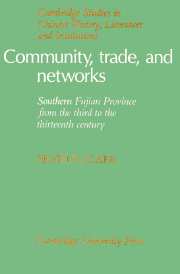Book contents
- Frontmatter
- Contents
- List of maps and tables
- Acknowledgments
- 1 Problems and approaches
- 2 The late Tang
- 3 The interregnum: politics, structure, and administration
- 4 The interregnum: society and economics
- 5 The Song: demography and networks
- 6 The Song: trade and economy
- 7 Conclusions
- Appendix 1 Townships (xiang), villages (li), and command brigades (dubao) under the Song
- Appendix 2 A discussion of population distribution
- Appendix 3 Pre-Song and Song bridges by district in twenty-five-year intervals
- Appendix 4 Place names in the Yunlu manchao and Zhufan zhi
- Appendix 5 Abbreviations
- Notes
- Glossary
- Bibliography
- Index
3 - The interregnum: politics, structure, and administration
Published online by Cambridge University Press: 13 October 2009
- Frontmatter
- Contents
- List of maps and tables
- Acknowledgments
- 1 Problems and approaches
- 2 The late Tang
- 3 The interregnum: politics, structure, and administration
- 4 The interregnum: society and economics
- 5 The Song: demography and networks
- 6 The Song: trade and economy
- 7 Conclusions
- Appendix 1 Townships (xiang), villages (li), and command brigades (dubao) under the Song
- Appendix 2 A discussion of population distribution
- Appendix 3 Pre-Song and Song bridges by district in twenty-five-year intervals
- Appendix 4 Place names in the Yunlu manchao and Zhufan zhi
- Appendix 5 Abbreviations
- Notes
- Glossary
- Bibliography
- Index
Summary
The era that followed the collapse of Tang authority in the South is known conventionally but inadequately as the Ten Kingdoms; I call it “the interregnum” to convey more accurately its temporal and political character. It was a time of political devolution, of local warlords existing autonomously within larger state frameworks, of turmoil. Yet at the same time it was an era of vitality, experimentation, and innovation. The Quannan that emerged from this century was vastly different from the one that entered it. I shall deal with this more fully in later chapters; here and in the chapter that follows I shall try to probe beyond the frustratingly limited materials of the interregnum to suggest just what processes were under way that were to propel Quannan from the obscurity of the ninth century toward the prominence and wealth of the eleventh.
Political history
Before examining the broader transformations of the interregnum, it is important to review the unique politics of the period, for they provide a framework which was distinct from that of any other era and which was vital to all developments. Those politics began in 878 when Huang Chao and his rebel army swept through the South. As happened elsewhere, Huang's depredations in the northern part of Fujian prompted a local landowner of Jianzhou, one Chen Yan, to form a private army to chase him out. Just how great a role Chen's army actually played is debatable. Sources claim that his band of enraged peasants did what the remnant imperial forces could not – they chased Huang out of Fujian.
- Type
- Chapter
- Information
- Community, Trade, and NetworksSouthern Fujian Province from the Third to the Thirteenth Century, pp. 38 - 51Publisher: Cambridge University PressPrint publication year: 1991



